

Several posts in the LULA Forum and further thinking about the importance of the grayscale to overall image quality sparked my interest in developing an expanded approach (based on what I have been doing heretofore) for testing the accuracy and neutrality of grayscale tonal rendition as well as the depth of tonal separation for rendering B&W shadow detail. As I shall be deploying this expanded approach in a forthcoming printer and paper reviews for LULA, I thought it useful to provide an article explaining this expanded approach.
Before getting into the details of the methodology, a quick recap on the logic of why photographers or other printmakers should be interested in the accuracy of profiles and the nuances of tonal separation. Careful photo editors work with a colour-managed set-up between monitor and printer; they use high-quality profiles firstly for editing (under soft-proof on their monitors) the color and tone values they wish to see emerging on paper from their printers and then use the same profiles again for making the prints. The underlying purpose is to reliably obtain expected printed results without wasting paper.
To achieve this objective we want printer/paper profiles that facilitate the accurate reproduction of the color and tone values we create in the image files when we edit the photos under softproof. Without this, what we see on paper from the printer will not likely resemble what we prepared under softproof on our displays. Evaluating the accuracy of a printer/paper profile informs on whether the purpose of profiling will be achieved.
In a good many of my published printer and paper reviews, I used the synthetic Color Checker printer target with known reference values of each patch for this evaluation (Figure 0).
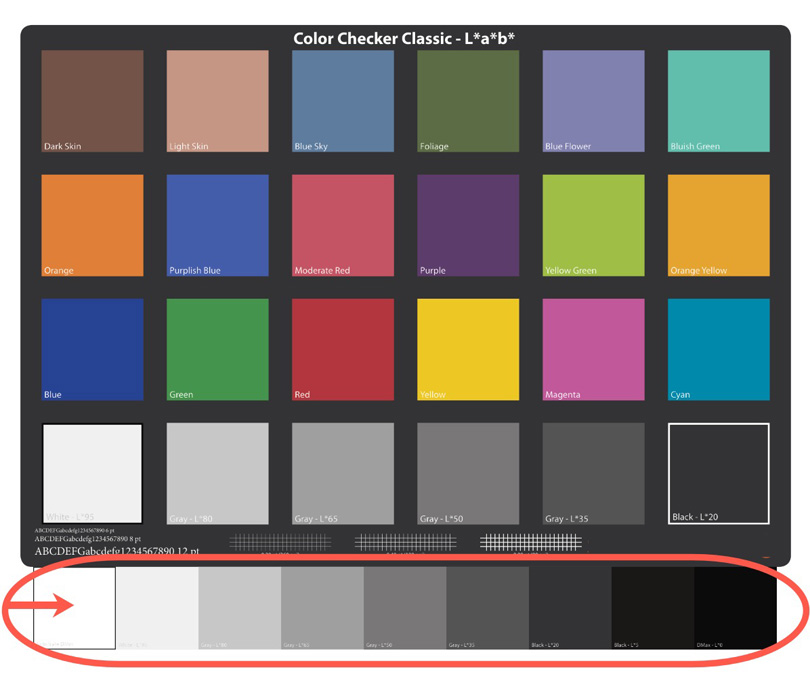
Underneath the 24 colors, there is a highlighted bar of nine additional grayscale patches that I used for a slightly more detailed look at grays than available in the Color Checker just above it. I remind, whether a “color” is a shade of gray or some other hue, all of them are colors with three coordinates defining those colors in L*a*b*, and that when a* and b* are 0, the color is a neutral gray, its tone depending on the value of L*.
The two new elements of my expanded B&W approach shown here include a more granular target that I developed specifically for B&W, as well as an accompanying Excel spreadsheet for implementing the data analysis from the measurement of this target. An image of the target (Figure 1) shows its two components.
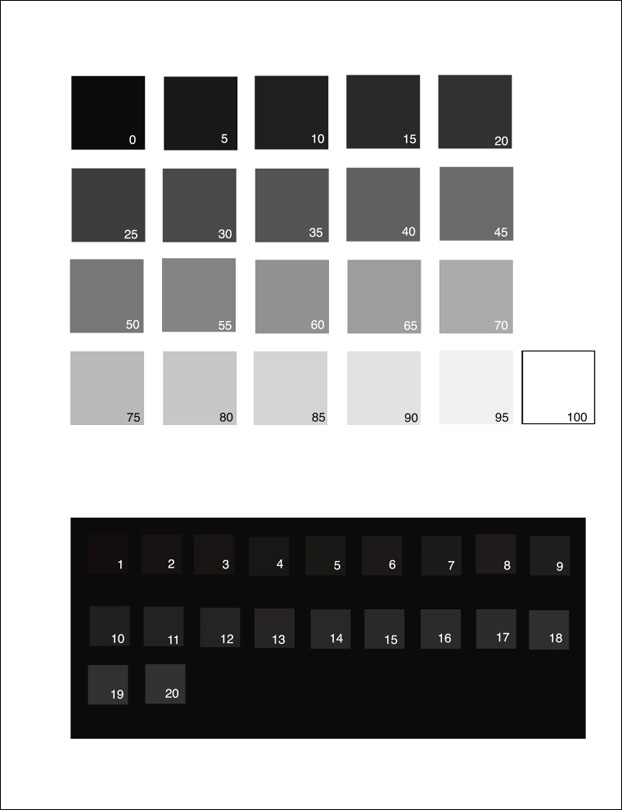
The upper component is for measuring the printed complete grayscale whose reference values range from L*0 (Black) to L*100 (White) in 21 steps – an expansion from the nine in Figure 0, and allowing for possibly a more representative averaging of dE results. The layout is designed for easy, reliable reading with an i1Pro2 spectrophotometer.
The lower component is for measuring a more granular gradation of the deepest shadow tones from reference values of L*0 to L*20 (21 steps) designed to show the separation of each step from its Black surround – and where on the tonal scale that separation begins, as well as to facilitate easy and reliable reading using the i1Pro2. As I have not profiled an inkjet paper whose Black rendition is weaker than L*20, I limited the range to L*0~L*20. It shows us numerically any difference between what the profile says is maximum Black (say read from ColorThink Pro) and what the printer/paper is actually rendering. This, then, may also be compared visually with the left-most patch on the target at which one perceives the start of tonal separation between the patch and its Black surround. As there will almost always be a difference between maximum Black of the source and destination profiles, this numerical and visual reading provides some insight into why, when printing real photos, one needs Black Point Compensation in Relative Colorimetric Rendering Intent to remap Black points from the source image to the printer profile, in order to either preserve deep shadow detail or prevent a washed-out look in the print.
The values in the lower right corners of each step in the target are the reference L* values.
I made the target in Photoshop in 16-bit TIFF mode, 360 PPI, composed the patch values in L*a*b* and verified them using the eyedropper and the info palette. I print the target in Photoshop using the paper/printer ICC profile under test, with Absolute Colorimetric Rendering Intent (ACRI). ACRI is the appropriate choice for proofing purposes because one wants to leave all in-gamut colors unchanged from their reference file color values – i.e. not scaled to produce departures from reference values as a result of the global color adjustments that the other Rendering Intents make to white points, black points or saturation. The measurement for accuracy must be based on reference values that are known and not altered in any way casting uncertainty on their luminance and chroma values.
Printers would not use ACRI for printing real photographs. They edit their soft proofed images using Relative Colorimetric or Perceptual RI, creating the required color values in the image files. If the measurement of the proofing-target printed with ACRI shows very low dE values relative to the target’s reference values, it means that the profile is quite accurate. Therefore, the printer should have confidence that all else equal (especially a properly calibrated and profiled monitor), those photos soft proofed and printed with RelCol or Perceptual RI will print quite accurately, having the tone and color appearance was shown on the monitor soft proof.
For analyzing the results of measurements made from prints of this target I created two spreadsheets, one for the upper portion and another for the lower portion of the Figure 1 target. These spreadsheets provide much useful information on the accuracy of tonal rendition (tones, hue, and tonal range) of the printed grayscale. The features of the spreadsheets are shown in Figures 2 and 3 for the upper and lower portions respectively, here using as an example the Canon Pro 1000 printer and Canon Pro Luster paper.

- Column “M” shows the Luminance scale L*0 to L*100 in L* increments of 5.
- Columns “N”, “O” and “P” show the dE of L*, a* and b* respectively for each patch.
- Column Q shows the dE of the combined a* and b* channels, giving a capsule impression of the extent of non-neutrality arising from either or both of the chroma channels.
- Column “R” shows the total dE of the patch (including Luminance and Chroma). All dE values are dE(76) – i.e. elementary differences unadjusted to take account of perceptual factors, because the intent here is to measure the accuracy of rendition from file values to the values measured from the print.
- Column “S” does likewise, but it excludes from total dE values that cannot possibly be reproduced accurately with existing technology and materials (e.g. 100% Black and 100% white).
- The bottom row provides averages of the columns of values above it. Hence in this example, the average of the total dE values is 1.79, or 1.52 omitting the extremes.
- The graph below the table provides a picture of total dE (green line), Luminance dE (black line) and chroma dE (red line), measured on the Y axis for the full luminance scale on the X-axis. The lines are NOT stacked, hence the dE scale on the Y axis applies directly to the position of each line on the graph independently of the other lines.
- Ideally, we want those lines to be very low and very straight. If they are not it could indicate significant errors that vary across the luminance range. It is important to judge these lines with reference to the range of dE values shown on the Y axis, and bearing in mind that dE outcomes less than dE1.0 are unlikely to be noticeable and between dE1 and dE2.0 subtly noticeable.
- The example above is pretty good for chroma, less so for luminance, and on the whole in the range of dE 2 +/- except at the extremes. This is a useful result.
Turning to the deep quartertones, to remind, Figure 3 shows the data from the measurement of the deep quartertone part of the Luminance scale from L*0 to L*20. The explanation of the data for Figure 3 is similar to that in Figure 2, except:
- For Col. “M” the luminance scale goes from L*0 to L*20 only;
- The averages of total dE as shown in Figure 3, bottom row apply only to their corresponding values above (scale of L*0 to L*20), in this example being 1.07 and 0.96 in Columns “R” and “S” respectively;
- The exclusions in Column S differ slightly from those of Figure 2, insofar as for the Figure 3 scale, all except L*0 and L*1 are technically achievable.
- While the outcome in Figure 3 looks very jagged, viewing the Y axis scale, most of the variance happens within a range of dE 0.25 to dE 1.5, a range that will be far less bothersome visually (if at all) than the lines suggest. The larger dE values at the lowest luminance levels reflect what the printer cannot reproduce.
In this trial exercise, I had intended to present an analysis verifying whether using the Black and White mode in the printer driver would deliver yet more accurate and more neutral results than I obtained using my custom profile for this printer/paper combination. I printed the target in ABW/B&W modes for both the Canon Pro-1000 and Epson SC-P800 printers, measured them and observed that the results were poor – much more so than suggested by viewing real photographs printed using these drivers. I believe the approach I am using here is likely inconsistent with how these B&W drivers are programmed to render image content, such that the effective reference values may not relate properly to those assumed in the spreadsheets.
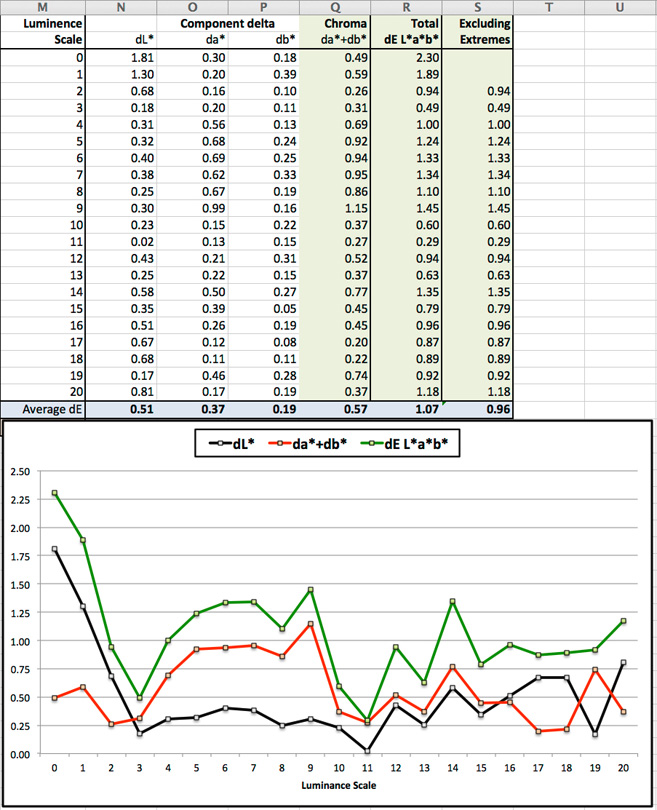
I then turned to making the same set of comparisons for the Epson SC-P800 printer using Epson Legacy Baryta paper (Figures 4 and 5):
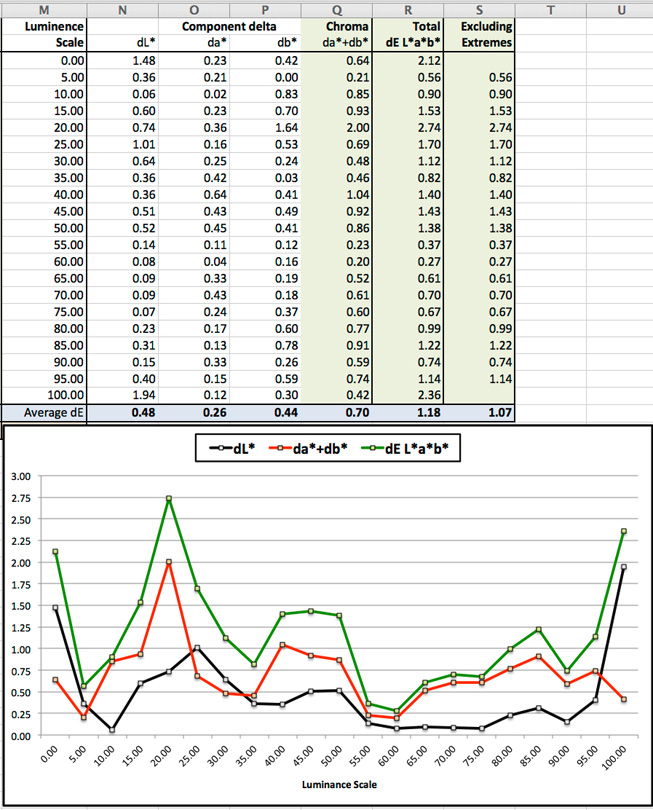
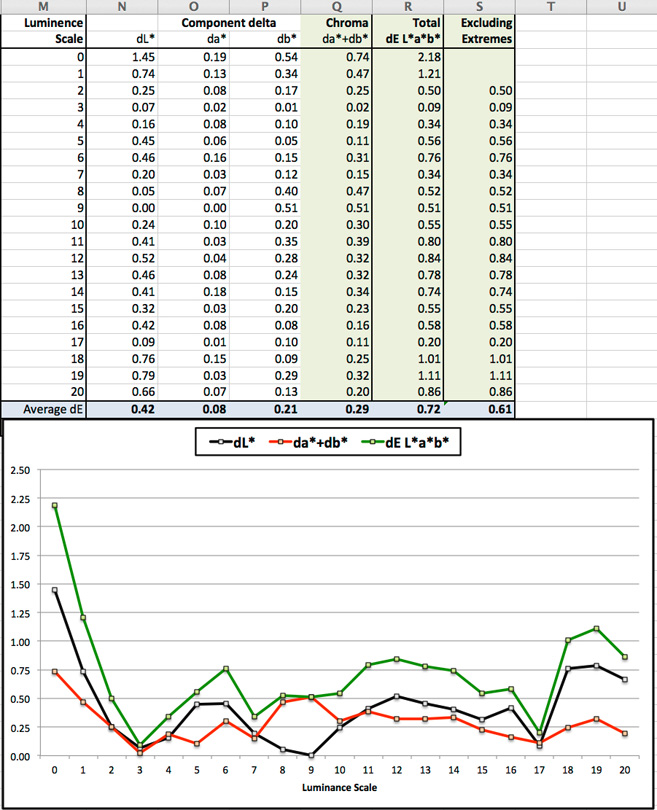
The overall result in Figure 4 (Luminance scale L*0 to L*100) is, on the whole, a very good one, but one wonders why the dE of the chroma spikes in the range of Luminance L*20~L*25. The dE values at the very bottom and top of the scale again reflect luminance that the printer/paper combination cannot reproduce.
The result in Figure 5 (L*0 ~ L*20 scale for the shadow tones) is impressive, with both overall and chroma channel dE being far below 1.0 for much of the scale. The Figure 5 Epson dE values are slightly lower than those for the Canon Pro1000 (Figure 3), but these are on the whole imperceptible or perhaps only subtly perceptible differences. As I’ve mentioned in my previous reviews, these new printers and papers have achieved a previously unmatched quality of rendition for Blacks and shadow separation in the quartertones.
This latter point – shadow separation in the quartertones – I thought worthwhile pushing further, this time not with formal dE measurements, but yet another way of graphically viewing and predicting whether a print pipeline will produce good separation of shadow detail.
Hence I developed a third analytical approach, which I’ll call “30 Neutrals”. It is intended to evaluate, using a graphical representation, how well a printer/paper/Rendering Intent combination can differentiate shadow tones from L*1 to L*30; (beyond this range, the lower mid-tones onward are less challenging for inkjet printers). As no current paper/ink combination can reproduce L*0~L*1, the data begins with L*1.
The underlying principle of “30 Neutrals” is that we only see detail as a result of a difference of brightness between adjacent tones. If adjacent neutral gray tones have the same tonal value (L*) on paper, we can’t perceive any difference between them (because there is none) and no detail would be apparent over that range of sameness in the print.
The evaluation target constructed for this test (Figure 6) contains a difference of one L* luminance level between each of the 30 patches progressing up the luminance scale from L*1 to L*30; one L*a*b* level is thought to be the minimum distance between any two colours that humans require in order to perceive a difference between them. If the image file contains the minimum required distances between adjacent tones but the print fails to replicate those differences, it will not reveal the intended shadow detail. This test shows graphically and numerically whether to expect the requisite tonal separation in the lower quartertones of the prints.
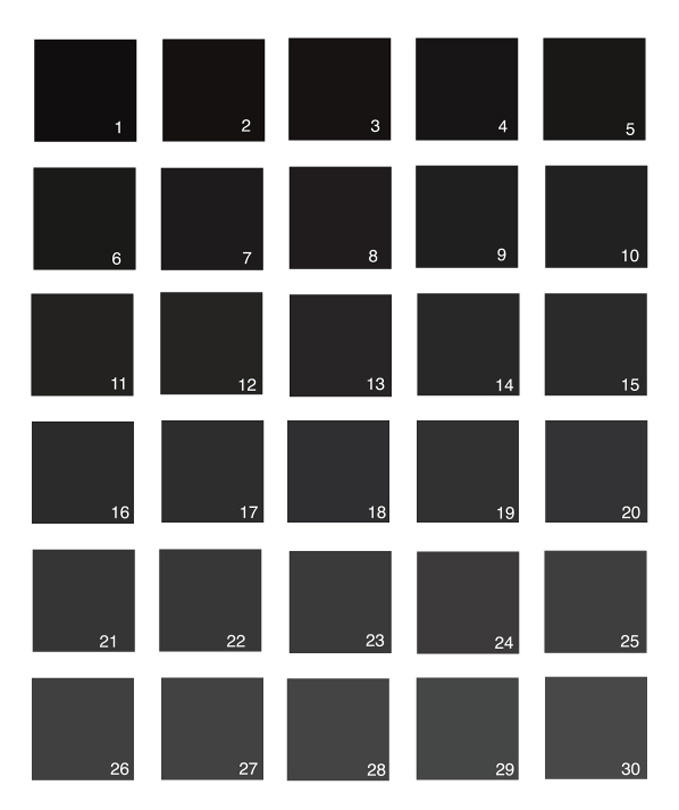
The procedure for testing the shadow separation performance of any printer/ink/paper combination is to print the target using either Absolute, Relative or Perceptual Rendering Intent, depending on the purpose, measure the resulting patches, and graph the results of those measurements. Sometimes it is interesting to compare Rendering Intents. “Absolute” provides an unadjusted rendition showing how the printer/ink/paper combination reproduces on paper a tone value in the image file without any remapping. The other two implement tonal remapping, as explained in the Adobe definitions of Perceptual, Relative Colorimetric and Black Point Compensation taken from within Photoshop (Figure 7):
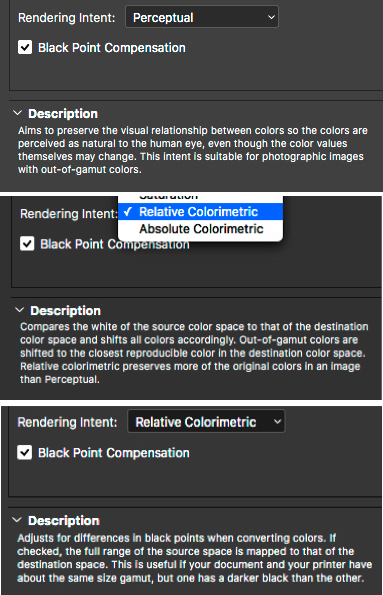
The patches are measured using i1Profiler with an i1Pro2 spectrophotometer, and the results saved in a CGATS text file format, then imported into Microsoft Excel and analyzed using an elementary analytical framework I developed for the purpose. The graph shows only the Luminance (L*) measurements of the patches. The spreadsheet also calculates the differences between file reference values and measured values of L*, a* and b*; the a* and b* components inform on neutrality, as the closer, they are to 0 the more neutral the outcome. The core output of the Luminance data (L*) is represented in the graph (Figure 8), which before adding in the measurements, always begins with one linear Black curve showing the Luminance reference values of the evaluation target.
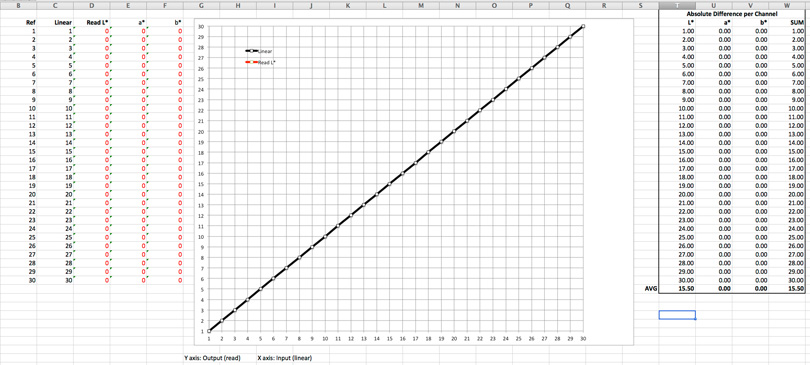
The Y-axis (vertical) is the L* metric for the output (results of measuring the patches), while the X-axis (horizontal) represents the input values of the target file. The linear curve of Figure 8 means that the output values are the same as the input values, which for this Black curve is true by construction. It is the reference curve, the slope of the line representing one Level of separation from one step to the next of each file input (horizontal axis) and its corresponding output (vertical axis).
After measurement of the printed patches, the measured (or read) values will show on this graph as a Red curve. Ideally, one wants the Red curve to converge as closely as possible with the Black curve, which would mean that all the measured tones are nicely separated and exactly reproduced relative to their file values. For added clarity, let’s look at a constructed “reasonable” outcome versus a constructed “troublesome” outcome (Figures 9 and 10 respectively).
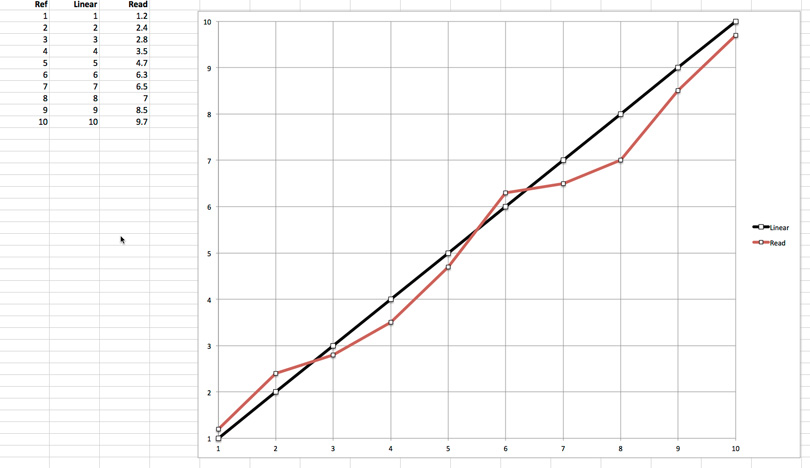
While not perfect, the “reasonable” outcome shows slope to the Red curve, indicating that the printed values (vertical axis) are separated from each other and hence those differences are likely to be visible, as we want them to be for seeing shadow detail.
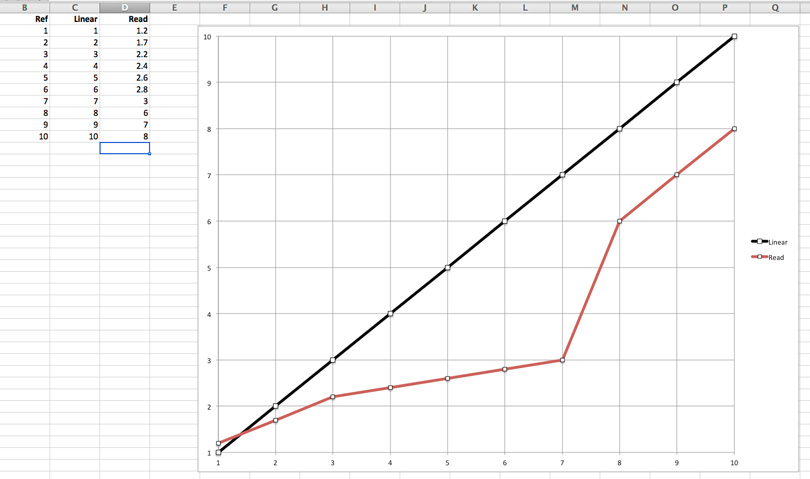
The “troublesome” outcome (Red curve) has three problems:
(1) All the values except for L* 1 and 2 are wrong;
(2) The curve is nearly flat between L* values 1 and 7 (Y axis) which means everything over that range will look pretty much the same when it is not supposed to (hardly any measured tonal separation considering that there are less than 2 levels of separation covering 7 levels of tonal difference in the image), therefore little to no shadow detail);
(3) There is a huge jump of 3 L* levels between L*7 and L*8, which could show up as a tonal discontinuity in the print for those levels, because instead of there being the correct 1 level of brightness separation between L*7 and L*8, there are 3, or said otherwise, printed 8 is three times brighter than printed 7 even though it is only supposed to be 1 brighter.
Bottom Line: For appropriate Luminance (L*) values allowing us to see the intended range of shadow tones, we are interested in how closely the measured lower quartertones (Red curve) adhere to the Black curve. Also, for evaluating neutrality, we are interested to see how closely the values for the a* and b* channels come to zero (Figure 6, the right side of the graph). The a* and b* columns show, in absolute numbers, the differences between 0 and the measured values for each patch. At the bottom of the a* and b* columns is the average of these differences for each channel. The closer the average to zero, the better the neutrality.
From tests I’ve done with matte paper, I’ve ascertained that the shape of the Red curve is a good predictor of what shadow detail will look like in real photographs. I shall apply this framework in forthcoming reviews to see differences of results between papers/profiles, between ICC and ABW workflows, and between Rendering Intents.
Mark D Segal
May 2017

Lorem ipsum dolor sit amet, consectetur adipiscing elit, sed do eiusmod tempor incididunt ut labore et dolore magna aliqua. Ut enim ad minim veniam, quis nostrud exercitation ullamco laboris nisi ut aliquip ex ea commodo consequat. Duis aute irure dolor in reprehenderit in voluptate velit esse cillum dolore eu fugiat nulla pariatur. Excepteur sint occaecat cupidatat non proident, sunt in culpa qui officia deserunt mollit anim id est laborum.
Lorem ipsum dolor sit amet, consectetur adipiscing elit, sed do eiusmod tempor incididunt ut labore et dolore magna aliqua. Ut enim ad minim veniam, quis nostrud exercitation ullamco laboris nisi ut aliquip ex ea commodo consequat. Duis aute irure dolor in reprehenderit in voluptate velit esse cillum dolore eu fugiat nulla pariatur. Excepteur sint occaecat cupidatat non proident, sunt in culpa qui officia deserunt mollit anim id est laborum.

Lorem ipsum dolor sit amet, consectetur adipiscing elit, sed do eiusmod tempor incididunt ut labore et dolore magna aliqua. Ut enim ad minim veniam, quis nostrud exercitation ullamco laboris nisi ut aliquip ex ea commodo consequat. Duis aute irure dolor in reprehenderit in voluptate velit esse cillum dolore eu fugiat nulla pariatur. Excepteur sint occaecat cupidatat non proident, sunt in culpa qui officia deserunt mollit anim id est laborum.
Lorem ipsum dolor sit amet, consectetur adipiscing elit, sed do eiusmod tempor incididunt ut labore et dolore magna aliqua. Ut enim ad minim veniam, quis nostrud exercitation ullamco laboris nisi ut aliquip ex ea commodo consequat. Duis aute irure dolor in reprehenderit in voluptate velit esse cillum dolore eu fugiat nulla pariatur. Excepteur sint occaecat cupidatat non proident, sunt in culpa qui officia deserunt mollit anim id est laborum.
Lorem ipsum dolor sit amet, consectetur adipiscing elit, sed do eiusmod tempor incididunt ut labore et dolore magna aliqua. Ut enim ad minim veniam, quis nostrud exercitation ullamco laboris nisi ut aliquip ex ea commodo consequat. Duis aute irure dolor in reprehenderit in voluptate velit esse cillum dolore eu fugiat nulla pariatur. Excepteur sint occaecat cupidatat non proident, sunt in culpa qui officia deserunt mollit anim id est laborum.
Lorem ipsum dolor sit amet, consectetur adipiscing elit, sed do eiusmod tempor incididunt ut labore et dolore magna aliqua. Ut enim ad minim veniam, quis nostrud exercitation ullamco laboris nisi ut aliquip ex ea commodo consequat. Duis aute irure dolor in reprehenderit in voluptate velit esse cillum dolore eu fugiat nulla pariatur. Excepteur sint occaecat cupidatat non proident, sunt in culpa qui officia deserunt mollit anim id est laborum.

Lorem ipsum dolor sit amet, consectetur adipiscing elit, sed do eiusmod tempor incididunt ut labore et dolore magna aliqua. Ut enim ad minim veniam, quis nostrud exercitation ullamco laboris nisi ut aliquip ex ea commodo consequat. Duis aute irure dolor in reprehenderit in voluptate velit esse cillum dolore eu fugiat nulla pariatur. Excepteur sint occaecat cupidatat non proident, sunt in culpa qui officia deserunt mollit anim id est laborum.
Lorem ipsum dolor sit amet, consectetur adipiscing elit, sed do eiusmod tempor incididunt ut labore et dolore magna aliqua. Ut enim ad minim veniam, quis nostrud exercitation ullamco laboris nisi ut aliquip ex ea commodo consequat. Duis aute irure dolor in reprehenderit in voluptate velit esse cillum dolore eu fugiat nulla pariatur. Excepteur sint occaecat cupidatat non proident, sunt in culpa qui officia deserunt mollit anim id est laborum.

Lorem ipsum dolor sit amet, consectetur adipiscing elit, sed do eiusmod tempor incididunt ut labore et dolore magna aliqua. Ut enim ad minim veniam, quis nostrud exercitation ullamco laboris nisi ut aliquip ex ea commodo consequat. Duis aute irure dolor in reprehenderit in voluptate velit esse cillum dolore eu fugiat nulla pariatur. Excepteur sint occaecat cupidatat non proident, sunt in culpa qui officia deserunt mollit anim id est laborum.

Lorem ipsum dolor sit amet, consectetur adipiscing elit, sed do eiusmod tempor incididunt ut labore et dolore magna aliqua. Ut enim ad minim veniam, quis nostrud exercitation ullamco laboris nisi ut aliquip ex ea commodo consequat. Duis aute irure dolor in reprehenderit in voluptate velit esse cillum dolore eu fugiat nulla pariatur. Excepteur sint occaecat cupidatat non proident, sunt in culpa qui officia deserunt mollit anim id est laborum.
Lorem ipsum dolor sit amet, consectetur adipiscing elit, sed do eiusmod tempor incididunt ut labore et dolore magna aliqua. Ut enim ad minim veniam, quis nostrud exercitation ullamco laboris nisi ut aliquip ex ea commodo consequat. Duis aute irure dolor in reprehenderit in voluptate velit esse cillum dolore eu fugiat nulla pariatur. Excepteur sint occaecat cupidatat non proident, sunt in culpa qui officia deserunt mollit anim id est laborum.
Lorem ipsum dolor sit amet, consectetur adipiscing elit, sed do eiusmod tempor incididunt ut labore et dolore magna aliqua. Ut enim ad minim veniam, quis nostrud exercitation ullamco laboris nisi ut aliquip ex ea commodo consequat. Duis aute irure dolor in reprehenderit in voluptate velit esse cillum dolore eu fugiat nulla pariatur. Excepteur sint occaecat cupidatat non proident, sunt in culpa qui officia deserunt mollit anim id est laborum.

Lorem ipsum dolor sit amet, consectetur adipiscing elit, sed do eiusmod tempor incididunt ut labore et dolore magna aliqua. Ut enim ad minim veniam, quis nostrud exercitation ullamco laboris nisi ut aliquip ex ea commodo consequat. Duis aute irure dolor in reprehenderit in voluptate velit esse cillum dolore eu fugiat nulla pariatur. Excepteur sint occaecat cupidatat non proident, sunt in culpa qui officia deserunt mollit anim id est laborum.
Lorem ipsum dolor sit amet, consectetur adipiscing elit, sed do eiusmod tempor incididunt ut labore et dolore magna aliqua. Ut enim ad minim veniam, quis nostrud exercitation ullamco laboris nisi ut aliquip ex ea commodo consequat. Duis aute irure dolor in reprehenderit in voluptate velit esse cillum dolore eu fugiat nulla pariatur. Excepteur sint occaecat cupidatat non proident, sunt in culpa qui officia deserunt mollit anim id est laborum.
Lorem ipsum dolor sit amet, consectetur adipiscing elit, sed do eiusmod tempor incididunt ut labore et dolore magna aliqua. Ut enim ad minim veniam, quis nostrud exercitation ullamco laboris nisi ut aliquip ex ea commodo consequat. Duis aute irure dolor in reprehenderit in voluptate velit esse cillum dolore eu fugiat nulla pariatur. Excepteur sint occaecat cupidatat non proident, sunt in culpa qui officia deserunt mollit anim id est laborum.

Lorem ipsum dolor sit amet, consectetur adipiscing elit, sed do eiusmod tempor incididunt ut labore et dolore magna aliqua. Ut enim ad minim veniam, quis nostrud exercitation ullamco laboris nisi ut aliquip ex ea commodo consequat. Duis aute irure dolor in reprehenderit in voluptate velit esse cillum dolore eu fugiat nulla pariatur. Excepteur sint occaecat cupidatat non proident, sunt in culpa qui officia deserunt mollit anim id est laborum.
Lorem ipsum dolor sit amet, consectetur adipiscing elit, sed do eiusmod tempor incididunt ut labore et dolore magna aliqua. Ut enim ad minim veniam, quis nostrud exercitation ullamco laboris nisi ut aliquip ex ea commodo consequat. Duis aute irure dolor in reprehenderit in voluptate velit esse cillum dolore eu fugiat nulla pariatur. Excepteur sint occaecat cupidatat non proident, sunt in culpa qui officia deserunt mollit anim id est laborum.
Lorem ipsum dolor sit amet, consectetur adipiscing elit, sed do eiusmod tempor incididunt ut labore et dolore magna aliqua. Ut enim ad minim veniam, quis nostrud exercitation ullamco laboris nisi ut aliquip ex ea commodo consequat. Duis aute irure dolor in reprehenderit in voluptate velit esse cillum dolore eu fugiat nulla pariatur. Excepteur sint occaecat cupidatat non proident, sunt in culpa qui officia deserunt mollit anim id est laborum.

Lorem ipsum dolor sit amet, consectetur adipiscing elit, sed do eiusmod tempor incididunt ut labore et dolore magna aliqua. Ut enim ad minim veniam, quis nostrud exercitation ullamco laboris nisi ut aliquip ex ea commodo consequat. Duis aute irure dolor in reprehenderit in voluptate velit esse cillum dolore eu fugiat nulla pariatur. Excepteur sint occaecat cupidatat non proident, sunt in culpa qui officia deserunt mollit anim id est laborum.

Lorem ipsum dolor sit amet, consectetur adipiscing elit, sed do eiusmod tempor incididunt ut labore et dolore magna aliqua. Ut enim ad minim veniam, quis nostrud exercitation ullamco laboris nisi ut aliquip ex ea commodo consequat. Duis aute irure dolor in reprehenderit in voluptate velit esse cillum dolore eu fugiat nulla pariatur. Excepteur sint occaecat cupidatat non proident, sunt in culpa qui officia deserunt mollit anim id est laborum.
Lorem ipsum dolor sit amet, consectetur adipiscing elit, sed do eiusmod tempor incididunt ut labore et dolore magna aliqua. Ut enim ad minim veniam, quis nostrud exercitation ullamco laboris nisi ut aliquip ex ea commodo consequat. Duis aute irure dolor in reprehenderit in voluptate velit esse cillum dolore eu fugiat nulla pariatur. Excepteur sint occaecat cupidatat non proident, sunt in culpa qui officia deserunt mollit anim id est laborum.
Lorem ipsum dolor sit amet, consectetur adipiscing elit, sed do eiusmod tempor incididunt ut labore et dolore magna aliqua. Ut enim ad minim veniam, quis nostrud exercitation ullamco laboris nisi ut aliquip ex ea commodo consequat. Duis aute irure dolor in reprehenderit in voluptate velit esse cillum dolore eu fugiat nulla pariatur. Excepteur sint occaecat cupidatat non proident, sunt in culpa qui officia deserunt mollit anim id est laborum.
Lorem ipsum dolor sit amet, consectetur adipiscing elit, sed do eiusmod tempor incididunt ut labore et dolore magna aliqua. Ut enim ad minim veniam, quis nostrud exercitation ullamco laboris nisi ut aliquip ex ea commodo consequat. Duis aute irure dolor in reprehenderit in voluptate velit esse cillum dolore eu fugiat nulla pariatur. Excepteur sint occaecat cupidatat non proident, sunt in culpa qui officia deserunt mollit anim id est laborum.

Lorem ipsum dolor sit amet, consectetur adipiscing elit, sed do eiusmod tempor incididunt ut labore et dolore magna aliqua. Ut enim ad minim veniam, quis nostrud exercitation ullamco laboris nisi ut aliquip ex ea commodo consequat. Duis aute irure dolor in reprehenderit in voluptate velit esse cillum dolore eu fugiat nulla pariatur. Excepteur sint occaecat cupidatat non proident, sunt in culpa qui officia deserunt mollit anim id est laborum.

Lorem ipsum dolor sit amet, consectetur adipiscing elit, sed do eiusmod tempor incididunt ut labore et dolore magna aliqua. Ut enim ad minim veniam, quis nostrud exercitation ullamco laboris nisi ut aliquip ex ea commodo consequat. Duis aute irure dolor in reprehenderit in voluptate velit esse cillum dolore eu fugiat nulla pariatur. Excepteur sint occaecat cupidatat non proident, sunt in culpa qui officia deserunt mollit anim id est laborum.

Lorem ipsum dolor sit amet, consectetur adipiscing elit, sed do eiusmod tempor incididunt ut labore et dolore magna aliqua. Ut enim ad minim veniam, quis nostrud exercitation ullamco laboris nisi ut aliquip ex ea commodo consequat. Duis aute irure dolor in reprehenderit in voluptate velit esse cillum dolore eu fugiat nulla pariatur. Excepteur sint occaecat cupidatat non proident, sunt in culpa qui officia deserunt mollit anim id est laborum.
Lorem ipsum dolor sit amet, consectetur adipiscing elit, sed do eiusmod tempor incididunt ut labore et dolore magna aliqua. Ut enim ad minim veniam, quis nostrud exercitation ullamco laboris nisi ut aliquip ex ea commodo consequat. Duis aute irure dolor in reprehenderit in voluptate velit esse cillum dolore eu fugiat nulla pariatur. Excepteur sint occaecat cupidatat non proident, sunt in culpa qui officia deserunt mollit anim id est laborum.
You May Also Enjoy...
Canon EF 28 – 300mm f3.5-5.6L IS Test
An Optical Analysis Using__________________________________________________________ In late January 2004 Canon announced two new zoom lenses, the28 - 300mm f3.5-5.6L ISand70 - 300mm f4.5-5.6 DO IS. Neither
